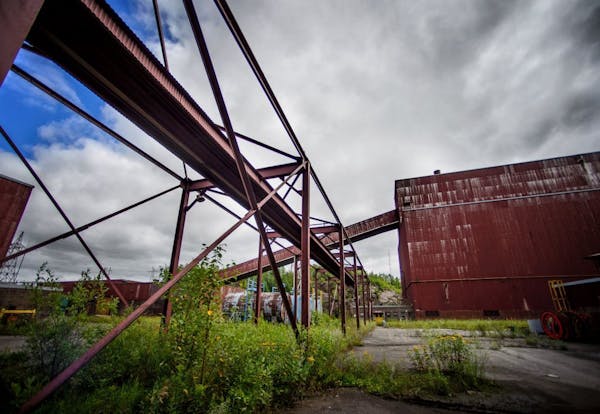Pushing back against the Trump administration, state regulators announced Friday that Minnesota will conduct its own, independent environmental review of the fiercely contested Twin Metals copper-nickel mining project because the state needs to ensure a "thorough, scientific and neutral review."
Twin Metals, which wants to build an underground mine on Minnesota's Iron Range, is expected to submit its official plan of operation next month, and the environmental impact statement, or EIS, is the all-important first stop before the yearslong permitting process begins.
"The credibility and transparency of the EIS process for the proposed Twin Metals project is critical to Minnesotans," Natural Resources Commissioner Sarah Strommen said in a call with journalists Friday.
Strommen also said her staff expects access to materials produced as part of a U.S. Forest Service study of the impact of hard-rock mining in a watershed of the Boundary Waters Canoe Area Wilderness. That review was canceled after President Donald Trump took office, and the materials have never been released despite multiple requests from members of Congress.
Strommen's decision means that the Twin Metals proposal will undergo two separate environmental reviews, a move that could create more conflict and potential delays for the mine the company wants to build just outside the Boundary Waters wilderness.
Strommen said she made the decision because the U.S. Department of the Interior wants to fold Twin Metals' application for a critical third federal land lease for an additional 1,000 acres into the environmental review. The state does not need to be involved in a federal leasing decision, she said.
In addition, she said that new Interior Department rules for environmental reviews create a problem with timing and scope. In 2017 the department announced a set of restrictions on the duration of federal reviews. It now requires its bureaus, including the Bureau of Land Management, to limit environmental impact statements to 150 pages and to complete them within 12 months. In the past, these crucial reviews have often taken years and resulted in long, detailed reports.
Asked for comment on Minnesota's decision, an Interior Department spokesperson issued a statement saying: "While the Bureau of Land Management will not be preparing a joint EIS with the State of Minnesota ... we will continue to work cooperatively with the state to reduce duplication and to coordinate our review of the project on matters such as data submittals, analytic approaches, and public participation."
It's not the first time Minnesota has opted to go solo on an EIS. It conducted its own environmental review in 2011 on a large Red River flooding plan known as the Fargo-Moorhead Area Diversion Project.
Twin Metals, a subsidiary of the Chilean mining giant Antofagasta, issued a statement saying that it shares the state's commitment to transparency and that it is committed to operating the mine "in an environmentally safe and sustainable manner."
"The agencies that oversee the environmental review of our project have robust processes in place to ensure we are held to the highest of standards," the company said.
'Entitled to Minnesota's land'
Two environmental groups that fiercely oppose mining outside one of the country's most popular wilderness areas said they support Strommen's decision, but called it premature.
"Whether Twin Metals can legally mine on this public land is still disputed," said Chris Knopf, head of Friends of the Boundary Waters Wilderness, which has filed a lawsuit with other groups challenging the legality of Twin Metals' lease renewals on the land.
"Our lawsuit … is still waiting for a decision in federal court," Knopf said. "This foreign-owned mining company is acting as though they are entitled to Minnesota's land, and we are confident we will win our case and they will not mine."
Becky Rom, who leads a second advocacy group, the Campaign to Save the Boundary Waters, said she wished Strommen had said the Department of Natural Resources would wait until the lawsuit is resolved.
"I'm not surprised that they chose to separate the state from the Bureau of Land Management and the federal government at this time, given their policies of environmental review," Rom said.
In all, Twin Metals has two dozen applications and requests for prospecting permit extensions before the Bureau of Land Management. Taken together, Rom said, the parcels cover much of the northern part of Superior National Forest, which drains into the Boundary Waters.
"I think what we're looking at is a massive conversion of the Superior National Forest into an industrial mining district," Rom said.
The Twin Metals mine, still many years away from materializing, would be the second copper-nickel mine in Minnesota if PolyMet Mining's $1 billion open-pit mine opens farther south, near Hoyt Lakes and Babbitt.
The projects have been embraced by supporters on the Iron Range and in Minnesota's business community, who welcome the jobs and economic benefits in a region of the state that has suffered steep losses of industrial jobs.
But conservation groups say the environmental risks of copper mining in the state's water-rich north are too great. The copper, nickel and other precious metals the companies seek reside in sulfide-bearing ore, which generates an acid when exposed to air and water that can leach heavy metals and other contaminants out of rock.
Jennifer Bjorhus • 612-673-4683

Over 27 years, couple have renovated Hopkins 'three-chimney house' built by Gluek family in 1939
Wanted man charged with posing as woman to lure men into sexually exploiting youngest of children

Jill Biden travels to Minnesota to campaign for Biden-Harris ticket
Want to celebrate 4/20? Here are 33 weed-themed events across Minnesota.

